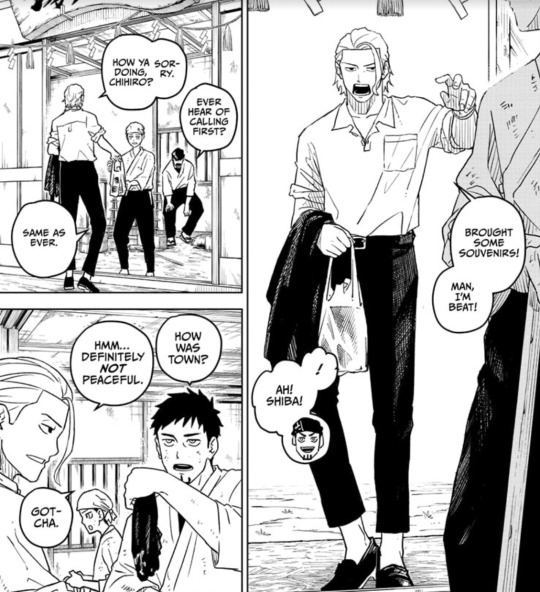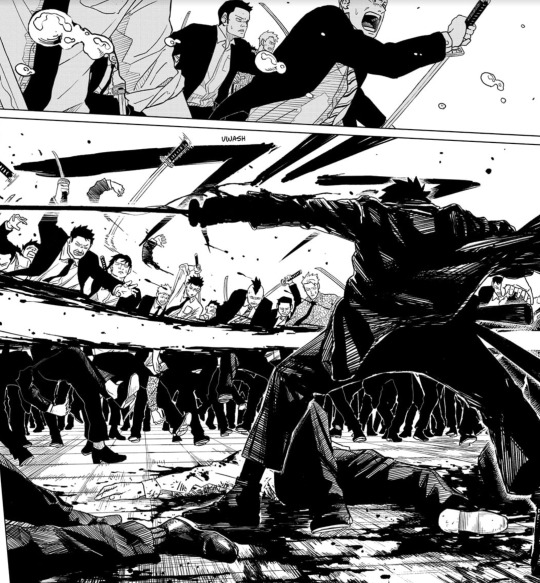#bachi layouts
Text






art cred : neko_964
#chifuyu matsuno#baji keisuke#chifuyu and baji#matching layouts#layouts#messy layouts#messy icons#matching layouts anime#packs#messy packs#anime layouts#bajiyu#chiba layouts#bachi layouts#tokyo revengers#tokyo revengers layouts#messy headers#messy
221 notes
·
View notes
Text
Kagura Bachi Chapter 1: Mission

At this point, I'm sure everybody's seen all the memes and jokes about Kagura Bachi. #1 New-Gen Shonen manga that's better than God himself, or whatever. A funny joke at times, but a little overdone.
Kagura Bachi would never live up to that hype, but it's also not a series that's going down the gutter right this second. It struggles, as a first time mangaka will, but at the very least has the potential to turn things around. So, let's take a look at this first chapter then and see what it can do.
The art. All the teaser images you've seen around make it look surprisingly good, and in some places it is. But the default? It's not really that good. It's not awful, but it's far from something you'll routinely comment on.
Simple designs, simple faces, and not a lot that changes about them. Honestly, I'd put it on the same level as the Fantasy Bishoujo manga that I talked about earlier, but even then I think the average quality of the art in Kagura Bachi can struggle to keep pace. Anyways, it certainly doesn't hold a candle to other recent SJ additions. Not awful to be at the bottom of the pack, but the art itself certainly isn't an immediate selling point for readers.

Diving further into the art and style, same-face is a real struggle with the shape and designs of characters. Eyebrows and pupil/iris shapes are some of the main ways the mangaka forces distinction between their characters. Truthfully, it's not something that's a deal breaker by any means, but just points to the struggles of an early on artist (though it's not like I can really say anything when I can't draw to save my life).
A more important issue however is the action. It's got solid layouts and ideas, but the choreography can feel.. plain. Not a bad thing, but you need art that can fill those gaps, that can provide pace and movement within. Kagura Bachi does not have the benefit of art that can help with that. And so, because of that, the action ends up stuff, and even lackluster.

Well, I suppose that's enough about the art, let's talk story.
... it's essentially on the same page as the art. Some good, some bad, lotta mediocre. Bog standard revenge plot meets unique but highly underutilized power system.
Chihiro is the son of a famous blacksmith, at some point his father dies and Chihiro is out for revenge against an organization of sorcerers that, we as readers assume, are the ones that killed his father. But Chihiro's just a boy, how could he go up against sorcerers? Well, he's got some special katanas from his departed father.
Very typical, no? Which I think is a shame, because the chapter deeply limits itself. It starts with the story stating that "only" Chihiro has magically imbued Katanas, but anyone with half a brain knows that as the series goes on, villains will wield similar katanas as well. To clarify, we know that Chihiro's father has made more than just the katanas that Chihiro has. The core of the gripe is that only Chihiro's father was able to create them, and that there's no information about how many there are or who might wield them (spoiler, it's gonna be all the bad guys).
The second, and more problematic issue is how the power system is approached. It separates sorcery from the katanas themselves, which is a painful mistake. The magic should be tied to the swords, it would make for a way better power system to explore. Swords vs magic has been done a thousand times over, so I'm just not thrilled to see its opportunity squandered.
That's not where it ends though. Despite being a magic sword, and despite readers knowing, thanks to earlier exposition, that it has the ability to "ward off evil", the manifestation of that ability is... to turn the sword black and slash people really hard.

I really can't get more disappointed than this. You lead with this super cool visual of the goldfish that the katana is imbued with, and you follow with a single slash. Not even a fancy one. Just a big, fat, shonen manga slash.

So, at the end of it all. There'll be an audience for this type of story, there always is. Violent revenge plot centered around black haired swordsman fighting non-sword wielding enemies. About as generic as you could make it, really. I just hope that the mangaka sees the potential that they wield and changes it up. Different schools centered around various imbued properties. Allowing Chihiro the use of sorcery to attempt to create his own blades. Distancing itself from the revenge plot. The art will undoubtedly grow and improve if the series is allowed to live, but in these early chapters.... well it's now or never for shifting the focus of the story. It has the ability to go the distance, but by the hand of the mangaka, the story is going down a path that will destroy its potential.
#kagura bachi#kagurabachi#shonen jump#shounen jump#weekly shounen jump#weekly shonen jump#weekly shonen magazine#カグラバチ#manga review#manga reccs#manga recommendation#anime and manga#manga
20 notes
·
View notes
Text
Kimono
Though the basic shape and construction of the kimono has not changed in centuries, proportions have varied wildly throughout different eras.
Beginning in the later Heian period, the hitoe - an unlined robe worn directly against the skin as underwear - increasingly began to be worn as outerwear, as the heavily-layered styles of women's dress in previous decades fell out of fashion.
Though courtiers continued to layer their clothing, the beginning of the Kamakura period marked the point at which the kimono began its rise as the predominant item of dress for everyday people. The hitoe worn in the Kamakura period were pulled up to be ankle-length, bloused over the hip with no belt on top, and had small, rounded sleeves that were sewn to the body of the hitoe.
In the following centuries, the hitoe mostly retained its small, narrow and round-sleeved nature, with the length of women's sleeves increasing gradually over time and becoming occasionally detached from the body. The collar retained its relatively long and wide (in modern comparison) measurements, with the okumi front panel having a longer and shallower angle towards the hem.
During the Edo period, the kosode - lit., "small sleeve", as it had come to be known - developed further into proportions similar to modern kimono today.
Changes in women's fashion led to longer and more dramatic sleeves gaining popularity, with the sleeves themselves definitively becoming unattached from the body to emphasise this and permit the increasingly wider and stiffer obi - with men's sleeves staying, for the most part, sewn shut to the body along much of their length.
The sleeves grew in proportion to be roughly the same width as the panels used on the body, and the collar on both men's and women's kimono narrowed in width and length.
In the present day, both men's and women's kimono retain some key differences held over from these previous proportions. Men's kimono should fall to the ankle, as they have roughly always done, where as a woman's kimono - historically worn trailing along the floor, then hiked up for convenience - should be as tall as the person wearing it, owing to the hip fold known as the ohashori worn underneath the obi. Though the collars on both men's and women's kimono are narrower, on formal women's kimono, the collar retains its historically wider width, being folded inwards before wear. This style of collar is known as hiro-eri, "wide collar", whereas a regular-sized collar is known as bachi-eri. On either type of kimono, the sleeves should fall to the wrist, though the constrictions of the fabric used may prevent this.
Historically, kimono were often taken apart to wash in separate panels, as the cutting layout for a kimono is little more than a series of rectangles - two long panels for the body (one for children) and two smaller panels for the sleeves, with smaller strips forming the narrow front panels and the collar. The kimono, once cleaned, would then be resewn by hand, with the standardised method of its construction allowing for it to be easily retailored to fit a changing body, or indeed another person. Though kimono are often machine-sewn in the present-day - with the exception of silk kimono - even a machine-made kimono will require hand-stitching to some degree.
Types of kimono can range in formality from the extremely informal to the most formal of occasions.
https://en.wikipedia.org/wiki/Kimono
0 notes
Text
Siriri (Audio) by Bipul Chettri
Siriri is a Nepali lok pop song by Bipul Chettri from album “MAYA”. Sonam Tashi is the executive producer of the song. Epiphone Guitars is the gear partner of the song. It features Bipul Chettri on the vocals and acoustic guitars.
The song Siriri is written, composed and arranged by Bipul Chettri. The innovative, energetic and multidimensional young singer Bipul Chettri has contributed his voice in lots of Nepali Songs with Lok pop genre. Bipul Chettri is originally from India(Darjeeling). Album Cover Layout & Design is contributed by Nima D.T. Namchu & Sidhu Gurdev whereas the official album partner is Honda Nepal. The song is mastered by Pete Maher, Top Floor Productions which is located in London, U.K. Give a listen to this song right away, I am sure you will keep repeating it.
The audio song is released officially online by Bipul Chettri via YouTube. Hope that you will enjoy this melodious lok pop song Siriri.
youtube
Here is the lyrics for Siriri:
Siriri hawa bagyo sustari
Yekanta duniyama malai pheri udai lagyo
Udi raheko bhuwa jastai malai udai lagyo
Mann ta aakash ma bagai lagyo
Jadai chhu kata tira
Bage chhu aakash nira
Aaune dina haru kaslai ke tha
Ma ta ahile ko lagi nai bachi rahechhu
Sapani lai khojda khojdai
Aafu lai nai bhulechhu
Jadai chhu kata tira
Bage chhu aakash nira
Jadai chhu kata tira
Bage chhu aakash nira
Aaha aahaa ha ha ha hai
Aaha aahaa ha ha ha hai…
Siriri ri ri…..
Jiriri ri ri…..
Jiriri ri ri…..
Jiriri ri ri…..
Siriri hawa bagyo sustari
Man ta aakashma udai lagyo…..
The post Siriri (Audio) by Bipul Chettri appeared first on etcNepal.com.
0 notes